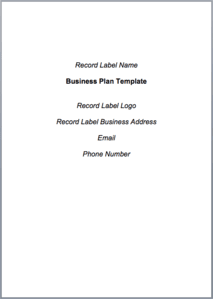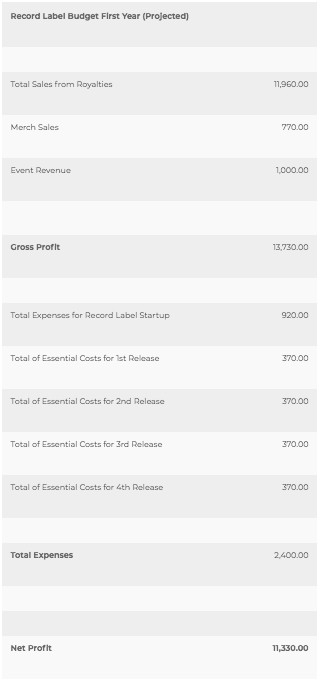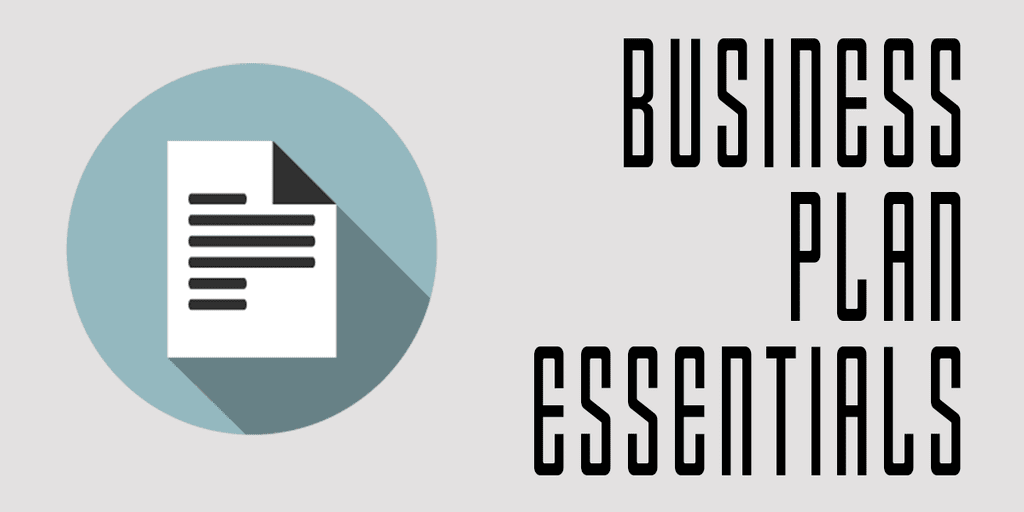In this article we look at the eight elements that make up a record label business plan, and work through the template providing examples you can edit for your own record label.
Writing a business plan
Running a successful record label is like running any other successful business, first and foremost you need a plan.
Every business I have started has begun with a plan. It doesn't need to be fifty pages worth of the minutiae account details but it is important to write down what your goals are for the first 12 months.
It's not just the final result that is important, the process of creating a business plan is equally important as it forces you to make realistic decisions on how you are going to move forward and make the label a success.

“If you fail to plan, you are planning to fail“
- Benjamin Franklin -
We can keep things simple and the whole document can be no longer than 6 brief pages. The main goal of the plan is to help clearly define what your brand will look like, which areas of music you want to focus on, and create a short summary that you can use to explain the label to new industry contacts.
In some countries you need a business plan if you are opening a business bank account. Some distributors also require a business plan before considering working with you, and you will definitely need one if you are an electronic record label and want a Beatport label account.
The good thing is that we have created The Label Machine business plan template that you can follow, which includes plenty of examples you can edit and customize yourself which will result in a comprehensive business plan for your label!
I would suggest before starting a label that you have at least three releases planned, with the first one ready to go. By ready to go, I mean you have a finished single or EP of music that is fully mixed down, mastered and ready to go out to the public without any more changes. The business plan will focus on these first three releases.
As you progress at The Label Machine, your business plan will change too, and it should. It is meant as a reference document that you can use to show others that you have a plan and well thought out goals.

Essential Record Label Business Plan Template
Download the full record label template to follow along with this article, including examples to edit for your own record label.
Download the template and open in your document editor and then we’ll go through each of the sections.
Below is a brief description of each section. Follow along and edit each section as we go along.
Title Page
This is the title section and front page of your business plan. This simply states your
- Record label name
- Business address
- Email address
- Phone number
1. Summary
This is the section that will summarise the main objectives of your label. This section will actually be written last. After you have completed the rest of the document, you need to come back and summarise it into a short paragraph here.
Example:
Zonderling Records is an electronic record label based out of Seattle, that aims to represent a genre of music heavy influenced by early rave, garage, jungle, and grime. We will produce limited edition runs of vinyl via vinylised.com, use interesting marketing ideas such as cassette mixtapes alongside traditional press and marketing channels.
2. Business overview
Introduction:
In this section you want to introduce the key people who are involved in the label and what experience, qualifications and training they might have, along with where you will be based and the future goals of the record label.
Example:
Joe and Rich have been involved with dance music for a long time and have over 4 years experience in music production and running small music related businesses. After releasing on various record labels in the past, the next logical step, to take their careers in the music business to the next level is to start a record label. The label will be Seattle based to begin with, but has the potential to be based out in LA within a few years of trading. Music will be the only product sold to begin with, but eventually the record label will be transformed into a brand big enough to sell clothing and other non-music related products.
Current position:
This is a summary of where you are right now with your music plans.
Example:
So far, Zondiling Records has the first release signed which is a Remix EP of Joe and Rich’s previous releases. ‘Juke da Luke’ and 'Pressure Fresh' have been singled out as potential first outside signings amongst other potentials such as ‘Idle Kids’ and ‘Origins of 90’
Growth plan:
This is a summary explaining how you aim to grow your record label with your financial goals
Example:
After releasing our first three EP’s we will expand into more releases from other artists, pulling remix favours to associate as many established acts to validate the label as possible. Using Joe and Rich’s releases will help to attract an established audience to the label initially. After a year, we aim to be signing artists exclusively under 360 deals and pulling in profit from the labels merchandise as well.
3. Strengths, Opportunities and Core Values
Strengths and Opportunities:
This is where you will list your strengths and opportunities as a record label. It gives you an opportunity to create a USP and critical success factors. If you have something unique that will ensure success, such as a link to a key industry contact, or opportunity, this is where you should list it.
Example:
Strengths:
-Understanding of the current music landscape via our current DJing bookings
-Links to multiple artists with established fan bases
-Advise and industry support via The Label Machine
Opportunities:
-Access to industry database, press and music industry contacts
-Access to other artists in local area
Core values:
What is important to you as a label? Are you going to be pushing underground music, or are you pushing experimental music? Is this to release your own album to support a tour, or are you interested in working with more mainstream music and artists?
Example:
-To build a brand that people can trust and turn to for good quality music
-To have the confidence to push new music as opposed to just following recent trends
-To build on personal relationships within the music industry in order to create a successful brand that people trust and want to be associated with
4. Business strategy
Outline your business strategy for the first five years. These are your tangible goals. How many releases do you aim to have? Do you want to sign new artists? When do you aim to break even on the revenue?
As a bare minimum your goals should aim to release at least 3 singles or EP’s in your first year if you are a DJ or band, and 6-8 records of you aim to sign artists to your label. I would also aim to be breaking even from 12 months of your first release so the label is supporting itself financially.
The 3-5 year goals are what you will be doing should you achieve your first 1-2 years goals. These goals that are more flexible, and are likely to change but ensure you do write goals of where you intend to go.
Example:
1-2 Years
-To have a steady flow of quality releases, building the labels reputation.
-To have discovered and signed at least 2 exclusive acts to the label.
-To have broken even on all costings
3-5 Years
-To have a full roster of exclusive artists releasing under Zonderling Records.
-To have had at least 3 overall Beatport number ones within their relative categories.
-To be hosting smaller stages at festivals worldwide.
-To have office space in either London, Bristol or LA with 3 or more staff members.
5. Distribution and Label Products
List your distributor and any other label products you aim to offer at the label such as merchandise or running events.
Distribution channels:
Who will you distribute your music through?
Example:
Music distribution to all major stores of iTunes, Spotify, Apple Music, Deezer, Amazon, and Google Play via the DistroKid distribution platform.
Find the best
distributor now
Use this handy tool to find your ideal distribution partner
Events (optional)
If you are doing events, who will run the events and how will they be promoted?
Example:
Label events will be arranged with our contact ‘Zeal Promotions’ throughout North America, with our focus being on our home state Washington. Events will be promoted through local and national media coverage via ‘3rd Eye PR’
Merchandising (optional)
If you are doing merchandising, who will be responsible? Where will you sell and manufacture your merchandise? What prices will you use?
Example:
Abbie Street will organise and implement the merchandise for the label. It will be hosted on Shopify website, and manufacturing will be carried out by a print-to-order manufacturer based in Seattle.
6. Label Management and Operations
This is where you list who will be managing the label and any other team members you will have. You can also list here any key partners you will use, such as The Label Machine, merchandise companies, or management companies.
Example:
Label Management Team
Joe Stone – Label Manager
- Responsible for A&R, signing and managing new artists
- Managing the music distribution and royalties
- Administrating and registering the catalogue
Rich Fever – Marketing Manager
- Responsible for online marketing and PR activities for releases
- Overseeing the artwork and marketing asset creations
Abbie Street – Merchandise Manager
- Organise and implementing the merchandise for the label.
- Maintaining the Shopify website
- Fulfilling the manufacturing and shipping
7. Marketing
What are your marketing goals, objectives, targets and promotional activities for the label? You will want to answer these questions in the sections below.
Goals and objectives
Describe your goals and objectives around the marketing; list the campaigns and plans that you have in place and your strategies for the future.
Example:
-Research blogs and press publications that support your genre of music to create label brand recognition
-Develop innovative marketing plans that utilise chatbots and other cutting edge technologies to build an audience
-Increase sales through social media campaigns and PR strategies
-Increase awareness of artists and label with 3rd party revenue streams such film, TV and game sync deals
Target Market
Here is where you can clearly define your target market. Important to put the genre of music you will be releasing, locations and age group as a minimum.
Example:
We aim to sell to all audiences, but with a more biased approach by making sure we appeal to the up and coming bass music markets such as the U.S.A. and a core demographic of end users between the age of 14 and 30
Advertising and promotion activities
Describe what advertising platforms you will use to promote the label and the releases. You might want to list any creative ideas to get the brand out there, any PR companies you might use for your first release, and which social media platforms you will promote on. Click here to learn how to build your own music PR machine in a day.
Example:
-Using physical assets such as vinyl and cassette mixtapes we will create a rich online experience based on real life products, which we believe is missing from a lot of digital labels today.
-We will use a DJ promotion service ‘The 6th Degree’ to garner maximum DJ support from the industry.
-We will run Instagram promoted stories and sponsored Facebook posts to create awareness of new releases to fans of similar genres.
8. Financial budget and forecasts
This is the section where you can provide financial budget and forecasts, such as:
- Startup Label Expenses
- Release Expenses
- Optional Expenses
- Cashflow Forecast
- Optional Revenue Streams
- Profit and Loss Projection
There is a budget template and course on how to create your budget that will go into more detail. Once you have completed this and have your budget you can copy and paste the summary page into this section of the business plan.
Example:
Record Label Budget First Year (Projected) | |
Total Sales from Royalties | 11,960.00 |
Merch Sales | 770.00 |
Event Revenue | 1,000.00 |
| |
Gross Profit | 13,730.00 |
Total Expenses for Record Label Startup | 920.00 |
Total of Essential Costs for 1st Release | 370.00 |
Total of Essential Costs for 2nd Release | 370.00 |
Total of Essential Costs for 3rd Release | 370.00 |
Total of Essential Costs for 4th Release | 370.00 |
Total Expenses | 2,400.00 |
Net Profit | 11,330.00 |

Conclusion
Writing a business plan isn't easy, but with the downloadable template (which includes extra examples not here in the blog) you should be armed with enough information to put a great record label business plan together.
And don't put off starting! Start today, and spend just 15 mins working on your plan, you'll be surprised how much you will get done and you'll be in a much better place to start your record label.
Prefer to watch a video? Check out Nick's business plan walkthrough below.
